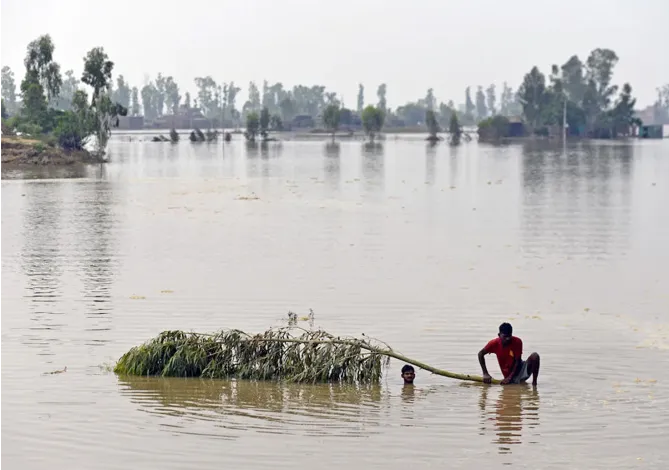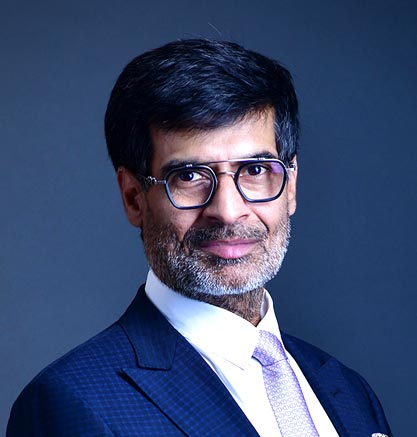-
CENTRES
Progammes & Centres
Location
Green technology and capital is concentrated in rich countries. Here’s how to address the north-south divide.

The recent United Nations climate summit, known as COP28, offered a glimmer of hope for international climate action. Negotiators struck a deal to transition the world away from fossil fuels and formally approved a loss and damage fund to support the countries that are most vulnerable to climate impacts. Yet COP28 fell short in one major area: It did not outline a clear pathway for funding and implementing climate action in the global south.
The implications of this will be felt around the world. Despite landmark U.N. climate agreements, global emissions have continued to rise. New research suggests that the world will breach the critical threshold of 1.5 degrees Celsius of warming above preindustrial levels by the end of the decade.
As emissions peak in the developed world, future emissions growth will be concentrated in the global south. Yet the resources needed to limit these emissions—namely, green technology and capital—are concentrated in the global north.
The global energy transition will only be successful if the international community fixes the north-south divide. Critical capital must no longer be withheld from the parts of the world that require it the most. There is an urgent need for leaders to reimagine climate cooperation. They can do this by ensuring that the global south has access to the financing, technology, and forums it needs to scale up energy access, support communities most affected by climate change, and make progress on climate targets.
The global energy transition will only be successful if the international community fixes the north-south divide. Critical capital must no longer be withheld from the parts of the world that require it the most.
Countries in the global south have felt cheated by international climate conferences that often overlook their voices and needs. These nations are particularly vulnerable to the impacts of a warming planet; in 2023, climate-induced natural hazards were among the foremost threats to lives and livelihoods in places including Libya, Yemen, Pakistan, and East Africa.
Yet countries in the global north have not only refused to make binding commitments to reduce emissions, but have also failed to deliver on the meager promises they have made, such as a 2009 commitment to provide $100 billion annually to the global south by 2020.
The resulting tussles between both sides distract from the real scale of the problem. It is not enough to think in terms of billions. The final text at the 2022 U.N. climate summit noted that the world would need to invest between $4 and $6 trillion annually in renewables and decarbonization solutions to transition to a low-carbon economy. Even less ambitious targets call for between $2 and $3 trillion in annual investments. Yet instead of identifying solutions to raise this kind of money, negotiators have fought over small, insignificant change.
Most of these investments will need to go to the global south. Currently, only around 25 percent of global climate finance, both private and public, flows to the global south. Yet in the next three decades, most global energy demand growth will come from these countries as they seek to address severe energy poverty. The International Energy Agency has estimated that one-quarter of this growth between 2019 and 2040 could come from India alone.
Since much of the global south’s energy infrastructure has not been built, there is an opportunity for development that does not follow the carbon-intensive pathways of the global north.
Most of these investments will need to go to the global south. Currently, only around 25 percent of global climate finance, both private and public, flows to the global south.
The good news is that green technologies have become increasingly cost-effective; the Intergovernmental Panel on Climate Change has estimated that the average cost of solar and wind energy and batteries has dropped by up to 85 percent since 2010. But the private sector only tends to see a clear business case for green investment in the global north, where more than 80 percent of total global climate finance is concentrated. In the global south, by contrast, only 14 percent of green investment comes from the private sector.
That’s because climate investment often requires considerable upfront capital and can take years to yield substantial returns. That initial investment has proved a hurdle for the global south to securing private funding. The International Energy Agency has estimated that the nominal financing costs for green energy can be seven times higher in developing and emerging economies compared with the United States and Europe.
This imbalance in capital costs is partly due to sovereign risk, or the political risks of investing in developing countries. Yet, while sovereign risk is real, it is often exaggerated and should not outweigh climate risk, which poses the greatest threat to the stability of the international financial system.
The technology needed to scale up green energy solutions also remains concentrated in the developed world and China. The global south often has to pay a heavy premium to use these technologies, including solar panels, wind turbines, and battery storage technologies.
Global leaders will need to resolve these disparities to meet their climate targets. Fortunately, climate action already aligns with much of the global south’s national development strategies. As the rotating president of the G-20 last year, India highlighted the need to place green development at the heart of climate action. But the global south can’t do it alone.
The global south often has to pay a heavy premium to use these technologies, including solar panels, wind turbines, and battery storage technologies.
There are four critical steps that the international community can take to rebuild trust in the climate action process and advance global cooperation.
First, the international financial system needs urgent reform to encourage more private funding in the global south. This will be essential to renewable energy projects and other mitigation measures. But it will also support adaptation efforts, including regenerative agriculture, drought-resistant practices, and low-cost community infrastructure such as bunds to protect against sea level rise and salination.
Multilateral and bilateral development institutions should expand financial guarantees and blended finance mechanisms to reduce the perceived risks associated with investments in the global south. For example, G-20 countries could create a pool of capital—administered by an agency such as the Multilateral Investment Guarantee Agency, which is housed in the World Bank—with the sole aim of reducing the cost of capital for climate-related projects.
Multilateral development banks must also be reformed to tackle the climate crisis. These banks can be instrumental in taking on some of the risks that hinder private capital flows to the global south. An independent committee under India’s G-20 presidency put forward a road map to reform such banks so that they prioritize eliminating extreme poverty; tripling sustainable lending levels; and creating a new, flexible funding mechanism. The G-20, as well as the World Bank and International Monetary Fund, should build on this road map by establishing hard timelines for implementing the reforms and ensuring support for green projects.
Second, the international community must ensure that the global south has access to technology it needs for the energy transition. In the health sector, there is a global understanding that while intellectual property protection is vital for innovation, governments may have to override protections in emergencies; in those rare instances, governments can turn to compulsory licenses to use a patent without the consent of the patent holder. Despite this precedent, the COVID-19 pandemic showed the world that even lifesaving technology may not flow quickly enough to the global south in a health emergency.
Before climate emergencies worsen, regulators and global institutions need to identify clearer mechanisms to share intellectual property rights for critical technologies and disseminate climate tech. This will be essential to ensuring that the green transition is not afflicted by severe delays and global disputes similar to those witnessed during the pandemic.
Emerging economies are also starting to see homegrown clean tech ecosystems driven by start-ups looking to disrupt traditional energy systems. Yet this sector suffers from a lack of public funds, reduced access to cutting-edge tech, and a shortage of early-stage risk capital to reach commercial scale. New mechanisms to connect risk capital in the global north to the clean tech sector in the global south will be essential to bridging the technology gap—for instance, a $100 billion fund that would disburse money to around 120 companies in the global south, including start-ups that plan to scale up climate tech.
Emerging economies are also starting to see homegrown clean tech ecosystems driven by start-ups looking to disrupt traditional energy systems.
Third, multilateral forums, such as the UNFCCC and the G-20, should better acknowledge the role of women in climate action, especially in the global south, and create women-led initiatives to mobilize support for political action on climate. Women are especially vulnerable to the effects of climate change—in many countries, they bear the responsibility of securing resources such as food and water that are made scarcer by global warming. Investing in female leadership will help shift the climate conversation from an elite discussion to one grounded in the real concerns of households.
Women are also the most likely to face health impacts from climate-related hazards, and public health systems worldwide will have to adapt to new climate-related risks. Putting health and gender equality at the center of the global climate conversation will create new reasons for climate action.
Finally, the world needs to build new pathways for climate cooperation. Despite geopolitical divides, nearly every country has a national action plan for climate mitigation and adaptation. Climate action has driven greater regional dialogue, including through the African Union’s Climate Change and Resilient Development Strategy and Action Plan and Central Asia’s Bishkek High-Level Dialogue on Climate Change and Resilience.
Climate action has also led to inadvertent cooperation among great powers, such as the United States and China. This kind of cooperation, which is often driven by the private sector, has been a key enabler of supply chains essential for green energy growth.
Countries with similar capabilities and concerns should collaborate in smaller groupings for faster and more ambitious action.
Climate cooperation can—and should—become a way to restore global stability and trust in multilateralism. Leaders should energize inadvertent cooperation through new partnerships, institutions, and dialogues. Countries with similar capabilities and concerns should collaborate in smaller groupings for faster and more ambitious action. The “climate club” that German Chancellor Olaf Scholz launched at COP28 to support decarbonization among some 36 member states is a good start. But the world needs an alliance with equal representation from partners in both the global north and south that can implement a binding finance package to channel transformative climate finance to the global south.
The international community must reimagine the global climate governance framework to address the scope of today’s climate challenge. As the clock ticks down to prevent catastrophic warming, only innovative approaches can mitigate damage to our planet. Key to this will be ensuring that the most vulnerable countries are no longer shut out of the capital and technology that they need to transition to green, resilient economies.
This commentary orignally appeared in Foreign Policy.
The views expressed above belong to the author(s). ORF research and analyses now available on Telegram! Click here to access our curated content — blogs, longforms and interviews.

Samir Saran is the President of the Observer Research Foundation (ORF), India’s premier think tank, headquartered in New Delhi with affiliates in North America and ...
Read More +
Danny Quah is a Dean and Li Ka Shing Professor in Economics, Lee Kuan Yew School of Public Policy, National University of Singapore ...
Read More +